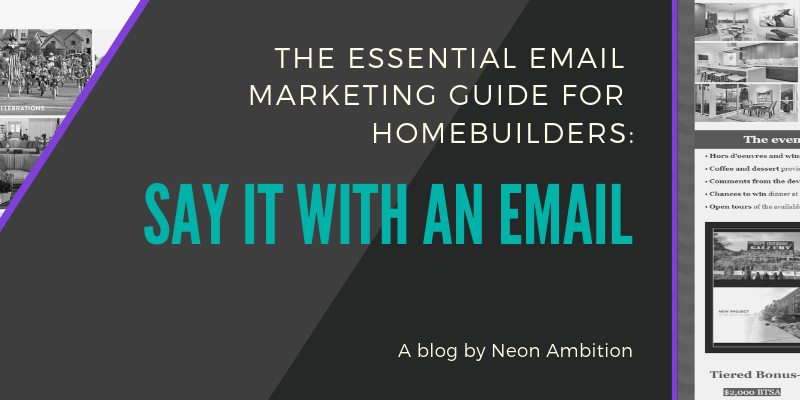Today’s marketers have plenty of sophisticated and innovative digital platforms at their disposal to spread their messages: social media, Google ads, landing pages, and more. Yet one of the most important channels isn’t that new at all — in fact, it’s been around since the seventies.
New marketing channels come and go, but email remains one of the most powerful tools in a marketer’s arsenal. Email is often considered more effective than social media, and usually boasts very high ROI as well. Email is typically cheaper than print media and easier to initiate than advertising campaigns. Other channels may be more valuable if you’re hoping to drive engagement or create buzz, but when it comes to reigniting interest or moving leads down the sales funnel, email is king.
Where email marketing really shines is in nurturing leads throughout a long sales cycle and widening your overall reach. To that end, it’s one of the key methods home builders can use to build and strengthen their relationships with home buyers as they navigate the complex process of shopping for homes. Furthermore, email can help you appeal to different audiences and speak to various aspects of your property. It can bolster other campaigns and projects, as well. Here’s the lowdown on email marketing for home builders and developers — and what you can do to make emails pay off in spades.
Table of Contents
ToggleWhy Email Works for Home Builders
The unique qualities of email marketing make it well suited to home builders. The flexibility of email means you can customize it in many different ways that will appeal to your various personas and leads that may be in different parts of the sales funnel. More specifically, here’s why we love email for home builders:
- It Can Be Automated. Using a marketing automation tool like Hubspot or Active Campaign, you can adjust settings to automatically trigger follow-up emails when recipients take certain actions, like clicking on a link or downloading a brochure. As you can imagine, this cuts down on manual administrative tasks, allowing your sales and marketing teams to spend their time on more valuable work. Automated emails also generate 320% more revenue than manual promotional emails. Those numbers alone make a pretty strong argument for automation.
- Some email programs like Lasso may not automatically send out emails on behalf of your sales reps, but allow you to design and tee up emails within the platform, which your sales reps can then send themselves. As long as your sales reps stay on top of their CRM tasks, this is a great option, as it allows reps to personalize email text to their desired specifications before sending.
- It’s Versatile. It takes a village to sell out a new development. Between realtors, your various target audiences, current residents and the general public, you probably have several different groups you’re looking to target. Because email lists can be segmented by different criteria, you can send differentiated messaging that will appeal to each group. The more you can personalize emails and send them at the right time, the more likely it is that recipients will respond.
- It Helps You Nurture Leads. According to research from Salesforce, it takes an average of six to eight touches to generate a viable lead. In today’s marketing landscape, buyers want to be as educated as possible — often doing a lot of their own research before they are ready to speak with a sales rep. When you’re marketing to home buyers, it may take an especially long time, since buyers want to be absolutely sure that a property fits their needs and wants before they commit. In fact, it may take a few interactions with your marketing collateral before buyers even request to speak with sales or sign up for a tour or event.
- Email helps you connect with leads in a noninvasive way. To sign up, buyers only have to enter an email address, rather than give away their full name, phone number and email address in order to request a tour. Email allows you to disseminate information that will help buyers decide if your property is right. It helps you nurture and develop leads until they’re ready to commit to a tour or call with a sales rep.
- It’s Promotional. A special event or offer can really bring home buyers out of the woodwork — especially if there are free goodies involved! But even the best event may fail if no one knows about it. Email blasts give you a way to spread the word instantly to hundreds of readers, and it’s less expensive than print ads, radio spots, and other advertising avenues.
- It Works in Harmony with Other Channels. A landing page, blog post, special event signup or content offer, like a free brochure, helps you collect email addresses and gauge interest. Email marketing adds value to these types of email gathering platforms by offering a way to stay in touch even after the memory of an interesting blog post or alluring brochure fades.
Email Campaigns That Work
Email campaigns can be very powerful: the average email has a 3,800 percent ROI, meaning every dollar you spend creating those tailored messages comes back with $38 in revenue. With budgets already stretched tight from construction, this is welcome news for most home builders.
Yet email still needs to be used strategically. It only takes a quick glance at your inbox to see how creative and sophisticated email tactics have become. If you want to compete, you’ll need segmented, personalized emails — and a variety of different tactics. The following are some strategies we recommend for home builders as they look to appeal to various markets and advertise different features of their properties.
- The Email Blast. Have an open house scheduled? Advertising a special or sale? Get the word out with a customized email blast. There are many ways to do this, but a countdown timer is a nice effect — it adds to the sense of urgency and taps into recipients’ fear of missing out.
- The Event Follow-up. Turnout at an event is a great sign that you’re having an impact on the homebuying public. But to keep the momentum going, you need to stay in front of attendees. Collect emails before and during your event, and send a follow-up email with a floor plan or brochure attached — and, of course, a way to get in touch with a sales representative.
- The Quizlet. Gauging the quality of new leads can sometimes be difficult, especially for those coming in from landing pages and other signup forms. A quiz embedded in an email provides more specific information about your recipients’ interests and needs. You can use the responses to create more specific email segmentation for even more tailored mailings.
- The New Feature Rollout. Whether it’s opening day at the on-site dog groomers or a new selection of custom cabinets, new features and amenities are cause to celebrate — with a promotional email. Use embedded photos, GIFs and videos to give recipients a taste of your new offering. Seeing is believing, after all!
- The Realtor-Ready. As you know, your relationship with realtors can make or break a property. Get on the good side of your local realtors with an email tailored just for them. One well-designed, long-format message highlighting all the important features makes it easy for realtors to get familiar with your property’s selling points without getting annoyed by too many emails. Very often they will save it for their records so they can later communicate the right information to customers.
The Dos and Don’ts of Email Marketing
Email can certainly pack a punch, but it needs to be wielded effectively if you hope to slay your sales numbers. Everyone has received a marketing email that was clumsy, uninteresting or just plain annoying. Don’t let your messages fall by the wayside. Instead, follow these tips to achieve emailing bliss.
- Do Make Sure Emails Are Optimized for Mobile. Most of your email list members will be looking at your message on a smartphone or other mobile device. Therefore, if your emails aren’t mobile compatible, recipients will simply delete them. In one survey, 80 percent of respondents said they delete emails not optimized for mobile on sight.
- Don’t Forget to Add a Clear Call to Action. Emails lose their power when recipients don’t know what to do with them. Help them understand the next step — and entice them into action — with a clear directive that stands out from the text of the email. Steer clear of adding competing links in the text that will reduce your click-through rate on your CTAs.
- Do Keep It Short and Snappy. As much as you might want to tell recipients everything about your new property, avoid the urge. An email that is succinct and to the point is much easier to digest. Considering that most people will be reading your email on the go, it’s important to state your case in as few words as possible.
- Don’t Muddle Your Message with Bad Design. Crammed text and jarring colors are more likely to give your recipients a headache than sell out your development. Choose your color palette thoughtfully, and pay attention to the amount of negative space. A little bit of space allows the eye to rest and directs attention to the most important parts of your email.
- Do Use Data to Create More Accurate Emails. Tracking click-through rates and conversions from email will help you understand what works and what doesn’t — and how well email is performing for you.
As you can see, email is at its most powerful when it’s designed to work with other marketing channels. All your campaigns and projects should work in concert to drive leads toward conversion. And that can be hard if you don’t have the resources or expertise to manage each one, or if you’re tied up overseeing multiple projects.
Check out a few of our client emails:
*Note: This blog has been modified to only render a few images for mobile users. To see the gallery, please view in desktop mode*{% gallery “gallery” %}
Luckily, you don’t have to master every single marketing channel for your efforts to lead to success. All you have to do is give us a shout here at Neon Ambition. We’d love to hear about your next project and discuss how email marketing can be a part of that vision and how it fits within your project’s broader strategy.








